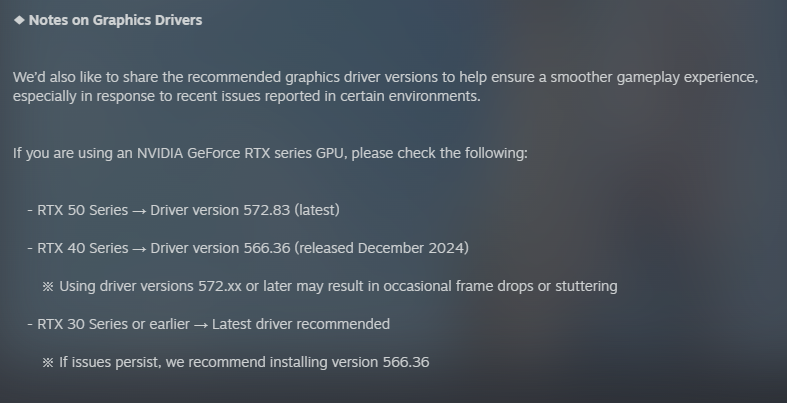A hot potato: With black/blue screens of death and system instability still affecting owners of GeForce RTX 4000 and RTX 3000 graphics cards, some game developers are now advising users to avoid Nvidia’s latest drivers or roll back to the December release.
Since updating to Nvidia’s 572.xx driver, several RTX 40- and 30-series users have experienced problems with some new games, especially Inzoi and The First Berserker: Khazan. Issues include crashes, freezes, stuttering, and sudden frame drops.
Inzoi developer Krafton wrote in its notes on graphics drivers that while it recommends RTX 50-series owners use the latest 572.83 driver, the same driver could cause frame drops and stuttering when playing the game on an RTX 40-series card. As such, it recommends using driver version 566.36 from December 2024. Any RTX 30-series owners experiencing issues are also recommended to use the older driver version.
The First Berserker: Khazan developer Neople wrote an identical recommendation in its notes for the best gaming experience.
The fact that developers of two very big recent games have been forced to issue these warnings illustrates just how widespread the problems have become.
It was back in February when we first heard of issues impacting cards from Nvidia’s RTX 50, 40, and 30 generations, with the Blackwell line being worst affected. They seemed to originate from Nvidia’s 572.16 driver release, which enabled RTX 50 support. There were reports of some users getting around the problems by capping their display’s refresh rate at 60Hz.
One person wrote that rolling back to the 566.36 driver was the only way to fix the problems impacting his Asus RTX 4070 Ti Super TUF card, the symptoms of which included Cyberpunk 2077 crashing his entire PC.
Nvidia confirmed that it was investigating the issues and would be releasing driver updates to address them, several of which have since been pushed out. While they seem to have fixed most of the problems impacting the RTX 5000 line, they haven’t been as effective for older graphics cards. It led to several users accusing Nvidia of prioritizing its latest cards while ignoring issues affecting the Lovelace and Ampere series.
With no sign of a fix on the horizon, those with previous-generation graphics cards experiencing the problems are becoming increasingly frustrated.
Source link

